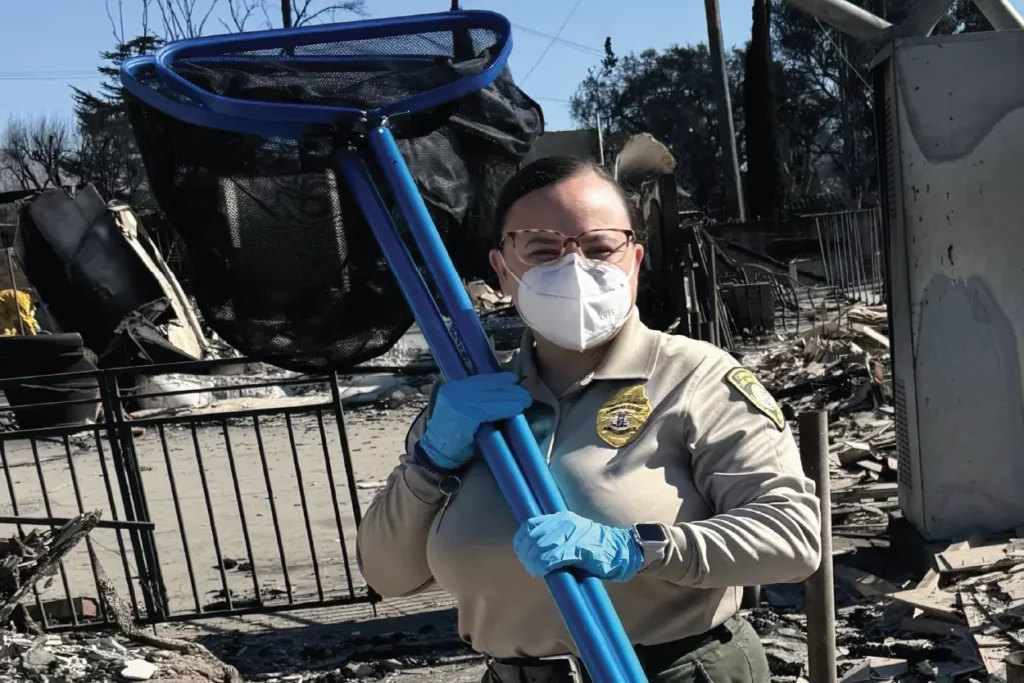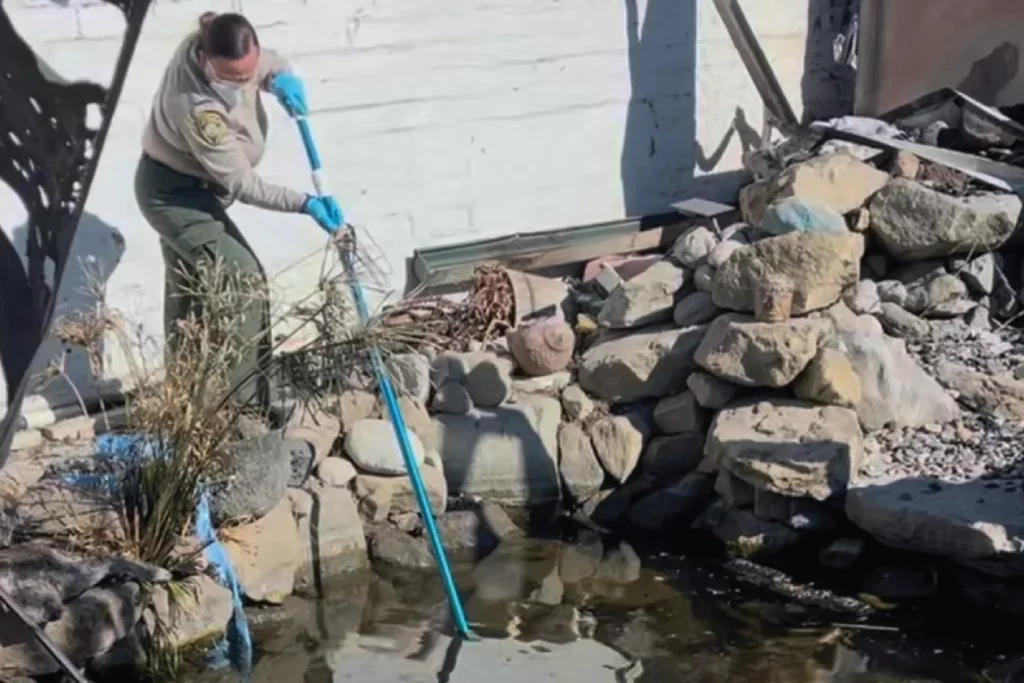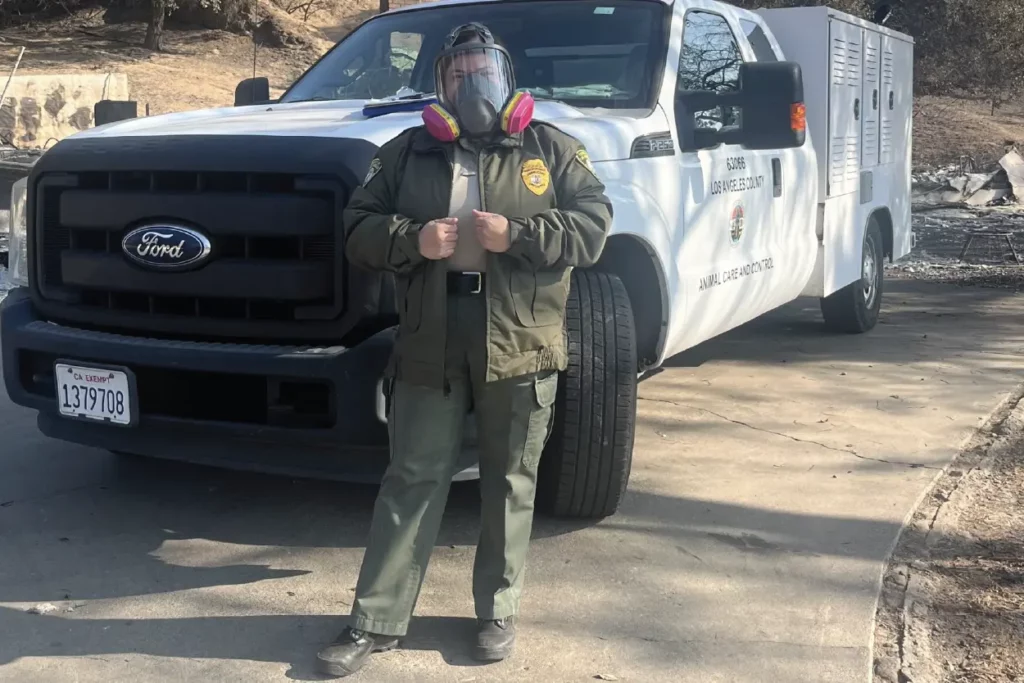
From October through December of 2024, Elizabeth Diaz’ job as an Animal Control Officer I required her to go door-to-door throughout the Altadena community doing animal licensing enforcement and education. But just mere weeks later, in January of 2025, she unexpectedly found herself back in Altadena traversing those same streets – this time to do Emergency Service Work in response to the massive Eaton fire.
“My specific job was to Rescue, Recover and Care,” explained Diaz, who has been with the LA County Dept. of Animal Care & Control for 20 years. “We had a Dispatch Command Center, and we were receiving calls from the community asking us specifically to go to their homes. They’d say, “I left my cat” or “I left my dog” and you try to see if they’re there. We’d also get calls from firefighters or the Sheriff stating that they noticed that there were animals there. There were a lot of koi calls or fish calls because a lot of the residents had outside ponds. One of my first calls were to rescue 14 koi fish that were left behind. We were able to secure nine and get them to a rehabilitation center. Our main goal was to rescue and then get them to rehab to make sure their lungs were fine, and they weren’t sick.”

At LA County, Animal Control Officers are considered Emergency Service Workers, and they oftentimes are a key part of emergency response. This was true in 2018 during the Woolsey Fire in the Santa Monica Mountains – where Diaz and her colleagues handled horse evacuations – and again this past January, when deadly infernos scorched through Pacific Palisades, Sylmar and Altadena.
“Our department was active as soon as the fires were happening,” Diaz said. “We have Command Posts and Animal Control is actively there to assist in evacuating as the fire is happening. At that point when I arrived, it was only 20% contained. Wind was a big concern at the beginning. By the time I got there, wind wasn’t the issue but trying to navigate through the rubble. I came home all dirty anyway and smelled like barbecue for days.”
The volume of work was heavy as the fire continued for weeks.
“There were so many calls,” Diaz continued. “We would get calls from other first responders, or we would get calls from the community. It involved dogs, cats, peacocks, goats, pigs, chickens. We’d get calls about racoons. We were alerted to a few bears and coyotes and mountain lions that we needed to be aware of in case they decided to come down. We were doing our best depending on what calls were coming in. But we were fielding wildlife and domestic animals.”

Diaz noted that if a resident’s home was past the fire line, Fire Department officials would not allow them to return to their homes – necessitating Animal Control Officers to take care of animals that were left behind. “At the time that I was there, we were able to reunite over 300 animals with their owners,” Diaz said. “One that I can share that stood out a lot is that I was loading up my Animal Control vehicle to head out on my dispatch calls when I was approached by somebody whose house I went to [during the previous autumn]. They shared that they lost their home, but they were able to take their dog. So, they were really excited to see someone they knew who had boots on the ground and who was working to try to find the other animals.”
The scale of the destruction was impossible to ignore, especially since Diaz had vivid recollections of what the neighborhood had looked like just a few weeks prior to the fire.
“When I got on the scene, the majority of the locations I was at, most of the houses had burned down to the ground,” Diaz recalled. “I was standing in a neighborhood where there were no houses and only chimneys. And that was really difficult to see. One of my recovery calls was [for] two dogs, and one was by the side of the home by where the trees were, and he was just curled up. His brother was in the pool. There was just no water – it was empty. I’m standing by the pool and I’m thinking, “How am I going to carry this big pit bull out from the bottom of the pool?” and I look up and the house is just gone – leveled. And it was just really something to see when you’re standing in a neighborhood where all these big, beautiful homes were there just a few weeks ago in a neighborhood we were familiar with – that we had walked through – and there was nothing, just chimneys. It kind of looked like an apocalypse. These cars that were just gutted and these houses that were destroyed – you have to ground yourself and remember what your course is. I remember standing here and telling myself: “Rescue, Recover and Care.” I would repeat that every time I felt overwhelmed.”
The tasks performed by Diaz and her colleagues at Animal Care & Control in response to the Eaton fire reminded her of the larger purpose of public service and the essential functions handled by emergency response workers.
“Just seeing all the first responders – it may not have been animal-related – trying to keep a community together,” Diaz said. “That was the silver lining – having people rebuild the community in big ways. Everybody mattered. Every hand, every job, everything we did mattered.”
 Share
Share
 Share
Share